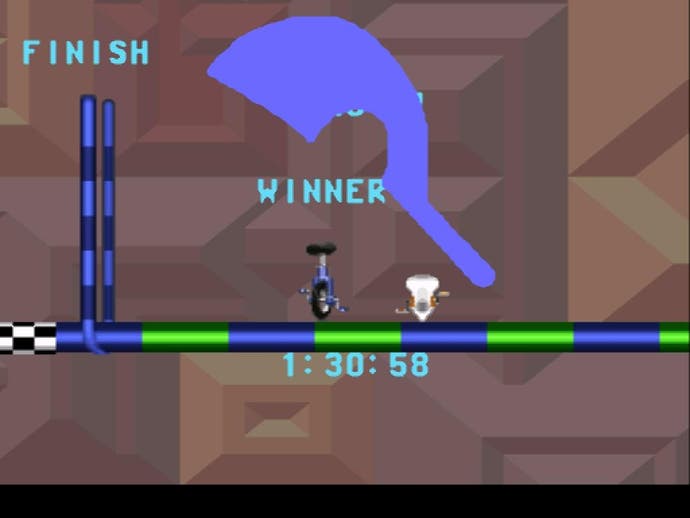Unirally retrospective
Bike of the thinning tread.
If you're looking for a handy example of how the gaming landscape has changed, just cast your eye in the direction of Unirally, DMA Design's SNES exclusive unicycle stunt racing game from 1994.
It has something that's all but disappeared from the mainstream console market today: simplicity. Today's boxed releases are nervous things, forever looking over their shoulder at the approaching digital and mobile horde, doing anything they can to justify their prolonged development, their massive design teams, their recession-busting price tags. Own a boat! Decorate a house! Upgrade your hair! Anything to make a game look more substantial and detailed, all the better to tempt the money from your wallet and remind you to please, please, keep spending forty quid each time.
Compared to such insidious feature creep, it's hard to believe Unirally was once a full-price console release. Here's the pitch: you race unicycles. That's it. Intuitive, accessible, simple.
Viewed from a side-on 2D perspective, you took part in fast one-on-one races along dizzying circuits of coloured pipes. Some were straight point-to-point races. Others traced laps around rollercoaster layouts. There are loops, sudden reversals, jumps and sections where you corkscrew around the outside of the pipework. Even with the 2D viewpoint, motion sickness was a real peril. Knowing how to anticipate these hazards and turn them into opportunities was a vital skill, and one you quickly acquired thanks to the game's astute learning curve. Key to victory, however, was stunts.

Once again, there's nothing fancy or confusing about the stunt system. While in mid-air, you can flip and roll in multiple directions, creating combinations that will hopefully cause the game to lavish you with slightly surreal praise. Every stunt successfully landed grants you an essential speed boost. Mess it up and come crashing down on your saddle and you slow down, giving your opponent the advantage. If you tire of the racing, the game's 45 courses, spread across nine cups, contained stunt-only events where every flip and roll earned points rather than speed.
Unirally also offered a commendable amount of depth for a multiplayer game of its vintage. Although the gameplay itself only ever supported two players via split-screen, it allowed for eight player tournaments with league tables and surprisingly detailed stats and charts, showing exactly how each player was matching up to the others in terms of speed, stunts and races won.
It's competitive gaming at its most basic and streamlined. There are no power-ups, no way for the game to favour one player over the other. Victory comes from cramming more stunts into the games frenetic races than your rival, and from being the fastest to react to the tortuous twists of the track. There's nothing here but graceful, ageless gameplay. No ill-advised gimmicks or features to date it, no over-reaching graphical effects to hold it back.
That's not to say it's an unattractive game. It doesn't look like much in screenshots, but in motion it's an absolute delight. The eerie riderless unicyles are weirdly expressive things, straining forwards like racehorses and bending like rubber while performing their gymnastic mid-air gyrations. Set to a pounding rock soundtrack, there's a charming cartoon-like quality to the game that more than compensates for the fact that, really, it's just the same pipes and wheels over and over again.
If anything, Unirally was a little too cartoon-like, as the design of the unicycles attracted the attention of fledgling animation studio Pixar, which promptly sued DMA Design for lifting the look of the cycles from its 1987 CGI short film, Red's Dream. Pixar's lawsuit was successful, and Nintendo was forced to immediately halt production of the game. In the end, only 300,000 copies made it out into the wild, effectively killing it stone dead.

Even though Pixar's case clearly had merit - the similarities are pretty obvious - it's a shame that Unirally's visuals couldn't be reworked to get it back on the shelves. It really is a lovely little game, with a clarity of focus that was rare in the mid-90s and is all but extinct in the retail games of today.
Even in the softography of DMA Design, it stands out as a curiosity, sandwiched between the all-conquering Lemmings series and the evolution into Rockstar, after the sprawling blockbuster success of Grand Theft Auto.
To revive Unirally now, it would have to be a digital download, or a mobile game, where its minimalist controls would be a snug fit. Indeed, you can see traces of Unirally's somersault-fixated gameplay in iOS games like Ski Safari, though it inevitably lacks the compelling urgency of a late night head-to-head joypad battle.
It was fiendishly addictive in 1994, and the SNES game of choice for multiplayer action during my student days, trumping such titans as Street Fighter 2 and Mario Kart. You can tell when a game has burrowed deep into your psyche when the most basic cues can transport you back to the time you first encountered them, and the driving guitars and tinkling sound effects of Unirally have that primal effect on me. That it's become increasingly obscure in the years since simply makes those memories all the more precious.
Having dusted off the old cartridge in 2012, I can confirm it's still fiendishly addictive today, and this longevity is almost entirely down to its laser-focussed simplicity. The best ideas don't need gizmos and distractions to justify themselves. It's an old truth that the modern games industry would do well to relearn.

